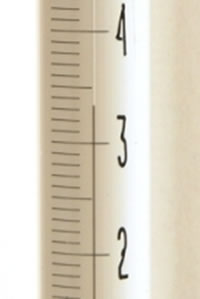Calibration Services
Temperature and Humidity: Contact Thermometry
Platinum Resistance Thermometers
 Platinum Resistance Thermometers
Platinum Resistance Thermometers
Standard platinum resistance thermometers (SPRT) satisfying the requirements of the ITS-90 may be calibrated at the appropriate fixed-points. For such calibrations it is necessary that the sensor element be mounted and sealed in a glass sheath so that the distance from the tip of the element to the bottom of the head of the thermometer is at least 450mm, and the diameter of the glass sheath should not be greater than 8mm.
Industrial platinum resistance thermometers (IPRT) designed for use as lower grade standards than those satisfying the requirements of the ITS-90 are calibrated by comparison with Laboratory standards.
The resistance ratios of the platinum resistance thermometer at the measuring temperatures will be determined and fitted to a polynomial. The coefficients of the polynomial will be reported.
Digital Thermometers
Digital thermometers will be calibrated by immersing their sensor probes in constant temperature baths or furnaces and comparing with Laboratory standards. The maximum calibration temperature is 1200°C.
If the diameter of the probe exceeds 8mm, or if the probe is bent or of irregular shape, or if the length of the probe (excluding handle) is less than 40 cm, there could be difficulty in providing the calibration. In such cases, please discuss with SCL the feasibility of the calibration.
Battery operated units must be submitted with batteries which are in good working condition, and fully charged. It is advisable to submit the battery charger or AC/DC adapter as well.
Temperature Loggers and Temperature Recorders
Temperature loggers and temperature recorders with multiple input channels will generally be calibrated as follows:
- Calibration at specified temperatures on one channel.
- Verification of all input channels at one test temperature or equivalent emf.
Liquid-in-glass Thermometers
 Liquid-in-glass Thermometers
Liquid-in-glass Thermometers
A thermometer submitted for test is examined for structural defects, errors in figuring and dividing, trapped gas or impurities, and excessive strain before calibration.
After examination, the thermometer is allowed to be stabilised in a standard condition. Calibration is usually commenced at the lowest test temperature and the chosen test points are calibrated sequentially. At each test point, readings are taken and compared with the Laboratory standards, in constant temperature baths.
Beckmann Thermometers
Beckmann thermometers are designed to measure small temperature differences. Hence the calibration of a Beckmann thermometer refers to comparing the true temperature differences obtained from the Laboratory's standard thermometers against the observed temperature differences indicated by scale readings of the unit under test. The measurements are carried out relative to a fixed base temperature.
Thermocouples
Thermocouples will be calibrated by comparison with Laboratory standards, in constant temperature baths or furnaces. The reference junction will be kept at 0°C. The maximum calibration temperature is 1200°C.
he inhomogeneity of the thermocouple wire will normally be evaluated to assess its effect on the calibration uncertainty.
The thermal emfs of the thermocouple at the measuring temperatures will be determined and fitted to a polynomial. The coefficients of the polynomial will be reported.
For thermocouples bearing serial numbers or markings for identification, certificates of calibration will be issued. Otherwise, calibration reports will be issued instead.
Thermocouples submitted should be no less than 1 m in overall length.
Bimetal Thermometers and Dial Thermometers
Bimetal thermometers and dial thermometers will be calibrated by comparison with Laboratory standards in constant temperature baths or furnaces.